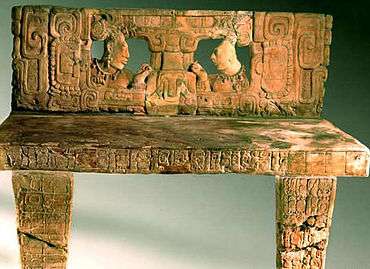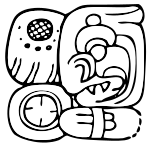Ha' K'in Xook
| Ha' K'in Xook | |
|---|---|
| Ajaw of Piedras Negras | |
|
Ha' K'in Xook's glyph, from Throne 1 | |
| Reign | 767–780 AD |
| Predecessor | Yo'nal Ahk III |
| Successor | K'inich Yat Ahk II |
| Father | Itzam K'an Ahk II |
| Religion | Maya religion |
Ha' K'in Xook (Mayan pronunciation: [haʔ k’in ʃoːk]),[nb 1] also known as Ruler 6, was an ajaw of Piedras Negras, an ancient Maya settlement in Guatemala. He ruled during the Late Classic Period, from 767–780 AD. Ha' K'in Xook was a son of Itzam K'an Ahk II, and he ascended the throne upon the death of his brother, Yo'nal Ahk III. Ha' K'in Xook's reign seems to have ended either with his death or his abdication in favor of his brother K'inich Yat Ahk II; archaeologists and Mayanists have not come to a clear consensus on this. Ha' K'in Xook left behind several monuments, including stelae at Piedras Negras and a stone fragment from El Porvenir. In addition, a stone seat known as Throne 1 which was erected by K'inich Yat Ahk II, records either the death or abdication of Ha' K'in Xook.
Biography
Reign of Piedras Negras

Ha' K'in Xook, who has also been referred to as Ruler 6,[5] was likely the son of Itzam K'an Ahk II, based on a translation of Stela 23.[2][6] According to both Simon Martin and Nikolai Grube, as well as Johnson, Ha' K'in Xook's name translates to "Water Sun Shark".[2] Of note, his name does not feature a turtle glyph, a feature found in all the previous rulers of Piedras Negras, as well as his successor.[7] He ascended the throne on February 14, 767 AD (9.16.16.0.4, 7 K'an 17 Pop in the Long Count),[2] following the death of his brother Yo'nal Ahk III.[8] Ha' K'in Xook's kingship of Piedras Negras had originally been overlooked by Tatiana Proskouriakoff, who instead assigned the title Ruler 6 to a misidentified sajal—or Maya leader—of La Mar.[6][9]
Not much is known about the rule of Ha' K'in Xook; his reign, along with that of Yo'nal Ahk III, has been referred to as "shadowy" by Flora Clancy,[10] and James L. Fitzsimmons argues that Ha' K'in Xook seems to have been a weaker ruler when compared to the reign of Itzam K'an Ahk II because Ha' K'in Xook erected few monuments, and he did not reinforce his power on a larger scale, choosing only to do so at local polities.[3] The only notable recorded event that has been preserved during the life of Ha' K'in Xook is of an incident that took place at El Cayo, most likely related to the burial of a contemporary sajal.[2] According to Zachary Nathan Nelson, the reign of Ha' K'in Xook seems to have been relatively free from war, as none of his extant stelae show representation of captives, and known records do not indicate any sort of "bellicose action" in the region during his reign.[9]
Death or abdication
In the night (of March 24, 780 9.17.9.5.11) Ha’ K’in Xok, Ruler 6, Lord of Piedras Negras abandoned the Lordship of Paw Stone place.
Translation of part of Throne 1 by Mark Pitts, detailing either Ha' K'in Xook's demise or abdication.[11]
Ha' K'in Xook yielded the throne on March 24, 780 AD (9.17.9.5.11 10 Chuwen 19 Sip).[2] The reason why his reign came to an end has been a topic of debate. Some believe that his reign ended with his abdication.[2][8] Throne 1, when translated, notes that he "abandoned/transferred rulership",[2] which American Mayanist Stephen D. Houston interprets to mean that he abdicated in favor of his brother, K'inich Yat Ahk II.[8] Mayanist David Stuart also noted that the wording on the throne "implies a more active event on the ruler's part", but that "'lose' might be more neutral as far as an interpretation goes."[4]
However, the exact phrase on the monument is yaktaaj ajawlel, which is the same wording that was used when the "burden" of leadership passed from K'ak' Tiliw Chan Yopaat, the k'ul ahaw of Quiriguá, to his successor Sky Xul during his burial ten days after his demise in 785 AD.[2][4][12] As such, this may suggest that, rather than abdicating, Ha' K'in Xook died in 780 AD, and his successor, K'inich Yat Ahk II, took up rule later.[2] The deciphered glyphs on Throne 1 note that K'inich Yat Ahk II later "remembered" Ha' K'in Xook at the Paw Stone Place in some way, and that the new king may have possibly wept at the memory of Ha' K'in Xook, according to anthropologist Oswaldo Chinchilla Mazariegos.[13]
Regardless, K'inich Yat Ahk II took up the throne on May 31, 781 AD (9.17.10.9.4 1 K'an 7 Yaxk'in), almost a year following the end of Ha' K'in Xook's reign. Despite this lengthy gap, there appears to be no evidence of anyone ruling Piedras Negras between the two kings.[14]
Monuments
 |
| Maya civilization |
|---|
| History |
| Preclassic Maya |
| Classic Maya collapse |
| Spanish conquest of the Maya |
Stelae
Several stelae have been found that were erected by Ha' K'in Xook, including Stelae 13, 18, and 23.[4] Stela 13 would appear to be the earliest, showing the oldest dedicatory date assigned to Ha'K'in Xook,[5] and it "captures the essence of the period-ending celebration."[14] This 2.39-metre (7.8 ft) tall stela retains stylistic elements of other niche stelae, but also shows a different form.[14] It depicts the king scattering incense,[2] similar to iconography found on Piedras Negras Stelae 2 and 32.[14] Clancy has argued that the stela contains iconography pertaining to three motifs: divination, "the quest", and accession.[15] Divination is shown via the act of Ha' K'in Xook scattering the incense.[2][15] This motif had been introduced earlier in the iconography of Piedras Negras by K'inich Yo'nal Ahk II. The stela also features Ha' K'in Xook wearing a unique headdress; it is depicted as being composed of three knots and forehead scrolls, a projecting Water Lily Jaguar, and a flexible rectangular emblem made from a jaguar pelt and a thick net. It has been postulated that this headdress was inspired by the headdress worn by an enthroned figure from the underworld featured on Stela 5.[15] Clancy argues that this headdress is a representation of "the royal theme of quest", due to its iconographic similarity to other stelae at Piedras Negras.[16] In addition, Stela 13 remains Ha' K'in Xook's only extant image.[10]
Not much remains of Stela 18, and what is left is badly worn. However, archaeologist Sylvanus Morley claimed that it expressed a Calendar Round date of 6 Ahaw 13 K'ayab (corresponding to a Long Count date of 9.17.5.0.0 or Dec. 27, 775), which Martin and Grube note is within Ha' K'in Xook's reign.[5] Stela 23 is the king's accession monument.[4] Originally carved on all four faces, this stela is in poor condition because it tipped over and shattered. The largest portions remaining include the base, and remnants of a basal panel of glyphs that feature the feet of two individuals. Similar to Stela 18, Martin and Grube argue that Stela 23 dates to the rulership of Ha' K'in Xook because the Calendar Round date on the monument is contemporary with the date found on Stela 13.[17] This stele details a puluuy utz'itil ceremony for Ha' K'in Xook's dead father, Itzam K'an Ahk II,[14] and, when translated, reads "Ruler 6 [Ha' K'in Xook], child of Ruler 4 [Itzam K'an Ahk II] … acceded to the rulership", seemingly proving that Ha' K'in Xook was indeed the offspring of Itzam K'an Ahk II.[6]
All three of the stelae were discovered by Teoberto Maler in 1901 near one of the site's main temple, the O-13 pyramid.[10] Stela 13 was possibly erected on a terrace reached by the pyramid's main stairway, and Stela 18 lies in a row on the plaza in front of the aforementioned stairway.[18] Stela 23, on the other hand, was erected at the very base of the pyramid.[4] This pyramid was most likely the burial place for Itzam K'an Ahk II, and—seeing as how Ha' K'in Xook, Yo'nal Ahk III, and K'inich Yat Ahk II all revered the site as a dynastic shrine—it is further evidence to back the argument that Ha' K'in Xook was the son of Itzam K'an Ahk II.[4][19]
Other
As mentioned before, Throne 1 details either the death or abdication of Ha' K'in Xook. However, it should be noted that the throne was not constructed by the king himself, but rather by his successor, K'inich Yat Ahk II. The throne was later deliberately broken apart by Piedras Negras's enemies, but has since been reconstructed.[11] In addition to on-site remains and relics, a fragment of stone found at El Porvenir and aptly called the "El Porvenir Fragment" was also discovered that bore the name of Ha' K'in Xook.[4][20]
Notes
- ↑ The ruler's name, when transcribed is "HA'-K'IN-XOK-ki", and when transliterated is "ha' k'ihn xook", according to Scott A. J. Johnson,[1] although it is commonly written as "Ha' K'in Xook".[2][3][4]
References
- ↑ Johnson 2013, p. 276.
- 1 2 3 4 5 6 7 8 9 10 11 12 Martin & Grube 2000, p. 151.
- 1 2 Fitzsimmons 2010, p. 154.
- 1 2 3 4 5 6 7 8 "Ha' K'in Xook". Mesoweb Encyclopedia. Retrieved February 6, 2014.
- 1 2 3 Clancy 2009, pp. 140–141.
- 1 2 3 Pitts, Mark (2011). "Ruler 6". A Brief History of Piedras Negras as Told by the Ancient Maya: History Revealed in Maya Glyphs (PDF). Pre-Columbian Society of the University of Pennsylvania Museum. pp. 157–161. Retrieved March 2, 2014.
- ↑ Clancy 2009, p. 141.
- 1 2 Nelson, Zachary (May 2005). "Settlement and Population at Piedras Negras, Guatemala" (PDF). The University of Pennsylvania. p. 35. Retrieved February 21, 2014.
- 1 2 3 Clancy 2009, p. 135.
- 1 2 Pitts, Mark (2011). "A Masterpiece of Maya Art". A Brief History of Piedras Negras as Told by the Ancient Maya: History Revealed in Maya Glyphs (PDF). Pre-Columbian Society of the University of Pennsylvania Museum. pp. 162–170. Retrieved March 2, 2014.
- ↑ Martin & Grube 2000, p. 222.
- ↑ Clancy 2009, p. 152.
- 1 2 3 4 5 O'Neil 2014, p. 142.
- 1 2 3 Clancy 2009, p. 143.
- ↑ Clancy 2009, p. 144.
- ↑ Clancy 2009, pp. 145–146.
- ↑ Weeks et al. 2005, p. 23.
- ↑ Martin & Grube 200, p. 150.
- ↑ Teufel, Stefanie (2004). "Die Monumentalskulpturen Von Piedras Negras, Petén, Guatemala" (PDF) (in German). University of Bonn. p. 215. Retrieved February 21, 2014.
Bibliography
- Clancy, Flora (2009). The Monuments of Piedras Negras, an Ancient Maya City. University of New Mexico Press. ISBN 9780826344519.
- Fitzsimmons, James (2010). Death and the Classic Maya Kings. University of Texas Press. ISBN 9780292781986.
- Johnson, Scott (2013). Translating Maya Hieroglyphs. University of Oklahoma Press. ISBN 9780806189406.
- Martin, Simon; Grube, Nikolai (2000). Chronicle of the Maya Kings and Queens. Thames & Hudson. ISBN 9780500051030.
- O'Neil, Megan (2014). Engaging Ancient Maya Sculpture at Piedras Negras, Guatemala. University of Oklahoma Press. ISBN 9780806188362.
- Sharer, Robert; Traxler, Loa (2005). The Ancient Maya. Stanford University Press. ISBN 9780804748179.
- Weeks, John M.; et al., eds. (2005). Piedras Negras Archaeology, 1931–1939. University of Pennsylvania. ISBN 9781931707756.
